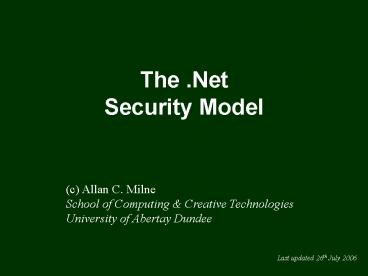The .Net Security Model - PowerPoint PPT Presentation
1 / 14
Title:
The .Net Security Model
Description:
Evidence-based security based on the code, not the user executing the code. ... Evidence-Based Security. Assigns permissions to an assembly based on evidence. ... – PowerPoint PPT presentation
Number of Views:42
Avg rating:3.0/5.0
Title: The .Net Security Model
1
The .NetSecurity Model
(c) Allan C. Milne School of Computing Creative
Technologies University of Abertay Dundee
Last updated 26th July 2006
2
Agenda
- The security system
- Role-based security
- Evidence-based security
- Evidence permissions
- Policy management
3
Introduction
- In addition to type verification the CLR also
implements a security model. - In this presentation we provide an overview of
the security model adopted by the .Net Framework. - The technical details of the operation of the
model is outwith the scope of this presentation.
4
The Security Model
- The security system uses two models.
- Role-based security based on roles and
identities. - Evidence-based security based on the code, not
the user executing the code. - Most aspects of the security system can be set by
an administrator.
5
Role-Based Security
- Similar to users and groups in the o/s.
- Uses two abstractions
- Identity represents the logical user.
- Principal representation of the roles belonging
to the user. - Each thread has only one principal and each
principal has one identity.
6
Evidence-Based Security
- Assigns permissions to an assembly based on
evidence. - The source location of the assembly is used as a
primary factor in determining evidence. - Evidence determines the assembly's permission to
use resources.
7
Outline Process
- The CLR of the hosting environment attaches
evidence to an assembly when it is loaded (either
from the GAC, download cache or storage). - This evidence is then mapped onto a set of
permissions. - These permissions determine access to specific
resources.
8
Evidence
- presented to the security system by the hosting
environment includes - zone (similar to that of IE)
- URL
- site
- source directory
- is matched against CLR policies to ascertain
permissions for the assembly.
9
Permissions
- represent authority to perform operations on
resources. - can be
- granted when loading an assembly, or
- demanded to check if permission has been granted
for a resource. - are collected into sets that can be combined in
various ways.
10
Policy Management
- The creation of permission sets from evidence is
performed by the policy manager. - This CLR component creates the permissions set
for the program by looking at policies set for
different levels of the environment. - Policies can be set by an administrator or
inspected and set programmatically.
11
Policy Levels
- There are four policy levels
- Enterprise
- Machine
- User
- Application domain
- Each level produces a permission set and these
are intersected to produce the permission set for
the program. - A higher level can override the requirement for
intersection of a lower level.
12
Policy Manager The CLR
Common Language Runtime
Assembly
Permission Sets
13
Stack Walks
- This is an essential but expensive part of the
security system. - When certain system resources are accessed a
stack walk may be demanded. - This verifies that all calls in the call chain
have appropriate permissions.
14
Activation Records
- A new activation record is put on the stack every
time a method is called. - An activation record contains parameters, return
address, and local variables. - In a stack walk each activation record in the
call chain is checked for appropriate permissions.































